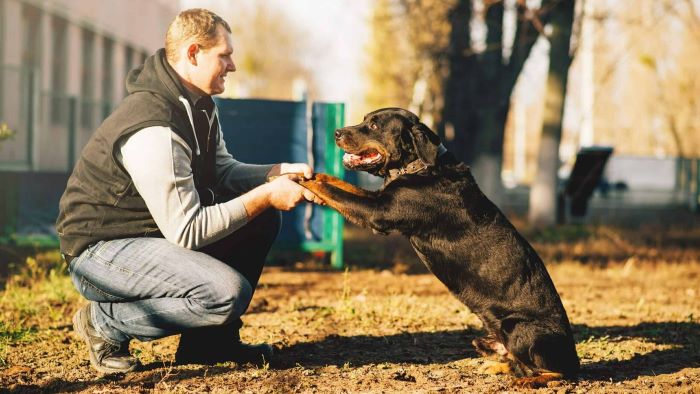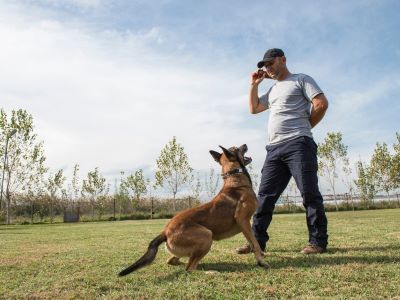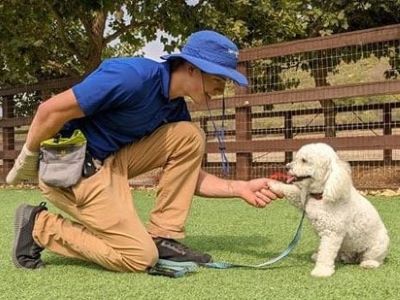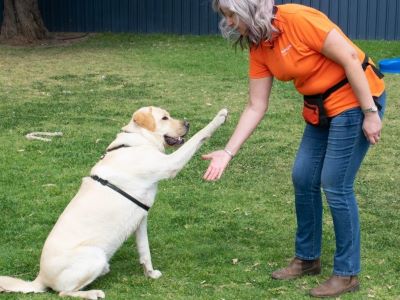Have you ever wondered what age to start dog protection training? It’s like asking, “When should my dog become a superhero?”🦸♀️

In this guide, we’ll explore when it’s best to start training your dog to be a protector. So, let’s find out when your furry friend can become your personal guardian in a straightforward way.🐶
What Age to Start Dog Protection Training?
While there’s no one-size-fits-all answer, experts generally recommend starting dog protection training around the age of one to two years.
Dog protection training should typically begin when the dog has reached physical💪 and mental maturity🧠, which is usually around 18 to 24 months of age for most breeds.
Younger dogs may not have fully developed musculature and skeletal structures required for rigorous protection training, which can put them at risk of injury. Starting too early may harm the dog’s physical development and interfere with their ability to grasp complex training concepts.
Waiting until the dog is mentally mature ensures they can handle the training with confidence and comprehension.
For breeds such as German Shepherds, Belgian Malinois, and Rottweilers, which are particularly apt for protection work, starting training at 18 months⌛ is recommended. These breeds tend to mature swiftly and are more likely to retain commands better as they have a stronger urge for work.

However, Large dogs like a Great Dane or Saint Bernard typically complete their physical growth later than smaller breeds, so it’s important that they develop the muscle strength needed to achieve peak performance in tasks relevant to protection training[1].
Certified Trainer
A certified trainer plays a key role in dog protection training due to the special and potentially risky nature of this training. Their qualifications and certifications are a testament to their expertise in protection training, often obtained from well-recognised organisations or institutions.🏨
Working with a professional trainer experienced in canine protection work is crucial to ensure both the safety and effectiveness of the training process.
These trainers possess the additional knowledge required for handling dogs in potentially aggressive situations, which is vital when teaching protection skills. Moreover, they understand the significance of rewarding your pup appropriately after each successfully completed task.🏆
Tips to Train Your Dog
Here are some training tips, By focusing on these training tips, you can help your dog become a well-behaved, socialized, and obedient companion, whether they are involved in protection work or any other role:
1. Basic Obedience
Start with teaching your dog basic obedience commands like “sit,” “stay,” “down,” “come,” and “heel.” These commands provide a foundation for further training[2].
- Consistency: Be consistent in your commands and use positive reinforcement techniques. Reward your dog with treats🍭, praise👏, and affection💖 when they obey commands correctly.
- Short Sessions: Keep training sessions short and engaging. Dogs have limited attention spans, so aim for 10-15 minute sessions several times a day.
- Patience: Be patient with your dog, and avoid using punishment-based methods. Positive reinforcement, such as treats and praise, works best to motivate your dog.

2. Socialization
Introduce your dog to various people, animals, environments, and situations from a young age. This helps them become well-adjusted and less prone to fear or aggression. Ensure that these socialization experiences are positive.
Encourage your dog to interact with others in a friendly and non-threatening manner. Gradually expose your dog to new experiences, starting with less challenging situations and progressing to more complex ones.
Control and Recall
Let’s see how can you control some actions of your dog:
- Control Exercises: Teach your dog to respond to commands even in distracting or high-stress situations. Use positive reinforcement to reinforce their ability to stay under control.
- Recall Training: Train your dog to come to you when called, regardless of what they are doing. Use treats and praise to reward prompt and reliable responses.
- Safety: A strong recall is essential for your dog’s safety, especially in potentially dangerous situations like traffic🚦 or when encountering other aggressive dogs.
Handler Training
As the owner and handler, you need to learn proper techniques for controlling and managing your protection-trained dog. Establish clear lines of communication with your dog. Understand their body language and signals, and use consistent commands.
Familiarize yourself with any specialized equipment, such as leads or harnesses, used for handling your protection-trained dog. Be actively involved in the training process to ensure that you and your dog work together effectively.

Regular Maintenance
Steady and consistent learning is the key, let’s understand in the detail:
- Ongoing Training: Continue with regular training sessions, even after your dog has learned the basics. This helps maintain their skills and reinforces your bond.
- Physical Exercise: Provide your dog with regular physical exercise to keep them healthy and release pent-up energy. Long walks, playtime, and other activities are essential.💪
- Mental Stimulation: Engage your dog’s mind with puzzle toys, obedience drills, or other mental exercises to prevent boredom and destructive behaviour.
Ensure your dog receives regular veterinary🧑⚕️ care to address any health issues promptly.
FAQs
Can Any Dog Be Trained as a Protection Breed?
While guard dogs tend to fall into the aforementioned categories of dog breeds, protection dogs can be any breed of dog. That’s because protection dogs are not trained to attack animals but merely to protect and defend their families. When a family chooses a protection dog, the protection dog can even be a small dog.
What Age to Start Dog Protection Training?
Assuming you have a dog with the genetic background to do the work, protection training should begin around 8 weeks of age. Certainly, this is rather infantile work at this age but begin! Begin early. Prey development will be a necessity.
What Is the Easiest Dog to Train for Protection?
German Shepherd Dog. One of the most popular personal protection and guard dogs is the German Shepherd Dog (GSD). They are one of the most common breeds and are intelligent, easy to train, and large and powerful enough to do the job. If a GSD is socialized and trained, excessive aggression is not a problem.
It’s a Wrap!
In our adventure through this guide, we’ve unlocked the secrets to transforming your furry pal into a superstar dog. From mastering basic tricks to becoming the life of the canine social scene, we’ve covered it all!
But hey, before we sign-off, let’s revisit our initial riddle: “What age to start dog protection training?” The real magic lies in the kindness and certified wisdom of your trusted trainers.🐶
So, as you both venture into this exciting journey, may it be filled with tail-wagging triumphs, paw-positive moments, and a bond as unbreakable as a knotted chew toy!
Reference:



